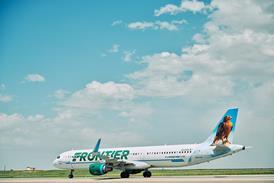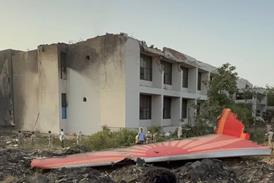Terma used the Paris air show to highlight its role in helping to protect the Lockheed Martin F-16s now being flown by the Ukrainian air force following the donation of surplus jets by several European allies.
Fielded by the European Partner Air Forces which operated the F-16 over several decades, Terma’s self-protection equipment has been included as part of transfers from the likes of Denmark and the Netherlands.
Combining missile and radar warning sensors with an electronic warfare controller and chaff and flare dispensers, the company’s PIDS+ pylon is now helping to safeguard fighter pilots for Kyiv.

While clearing the standard of equipment to be transferred to Ukraine was dependent on the receipt of approval from the US government, “They invested to have the aircraft as high as possible in specification,” Terma vice-president Europe defence Arjen Vos says. “Because nobody has an interest in weakening the protection of the F-16 in that theatre.”
In fact, “Sometimes we needed to change the configuration a little bit higher than the [previous] standard, where they wanted to add capabilities,” he told FlightGlobal at the Paris air show on 17 June,
Due to the sensitivity of the defensive mission in Ukraine and the way in which equipment is being supplied via the government in Copenhagen, Vos is unable to share details of any operational successes.
Asked how the PIDS+ technology is performing during the conflict, he provides a two-word summary: “As advertised. There is nothing coming back that didn’t work – [like] from other users as well,” he adds.
“It makes us proud that we serve these jets, because it all adds up in protecting them,” Vos says.
In addition to its use with Ukrainian air force F-16s, Terma says its PIDS+ pylon is “currently fielded on over 1,500 aircraft globally”.

At the show, it presented visitors to its exhibit with a commemorative patch depicting an F-16 with the flags of Denmark and Ukraine and its ‘Allies in innovation’ branding.
The company’s self-protection technology also is employed with a variety of helicopter models, and could be adopted for tactical transports and unmanned air vehicles (UAVs).
While it has long supplied pod-housed self-protection equipment for rotorcraft including the Airbus Helicopters H125M, Boeing AH-64 Apache, Leonardo Helicopters AW101 and NH Industries NH90, Vos cites “hugely increased interest in the last one to two years in the number of requests to add sensors and capabilities”.
As an example, it is currently competing for a requirement to supply equipment for the Netherlands’ on-order H225Ms.
“And we are looking more and more into the bigger types of UAVs, like [General Atomics Aeronautical Systems’] MQ-9B, that have limited protection. We are in talks with General Atomics, but also with end users, especially in Europe,” he adds.
“There is no pilot inside, but the bigger picture of self-protection is protecting the mission.”































